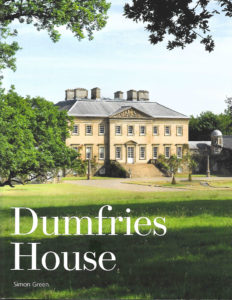 One of the things I had most looked forward to in an era that has seen a dearth of country house sales was the one scheduled nine years ago of the contents of Dumfries House. Is this politically incorrect? A heritage industry solecism? Of course it is, but I am unrepentantly acquisitive, and it is as a dealer that I fuel my obsession with buying things. Imagine, then, my initial disappointment when Prince Charles intervened at literally the 11th hour, saving the house and its contents for the nation.
One of the things I had most looked forward to in an era that has seen a dearth of country house sales was the one scheduled nine years ago of the contents of Dumfries House. Is this politically incorrect? A heritage industry solecism? Of course it is, but I am unrepentantly acquisitive, and it is as a dealer that I fuel my obsession with buying things. Imagine, then, my initial disappointment when Prince Charles intervened at literally the 11th hour, saving the house and its contents for the nation.
Oh, well, now I’ve offended every English Heritage, National Trust and Historic Homes Association card member, I must say that, absent owning a bit of the treasure trove of Chippendale furniture that had existed unchanged and in situ since placed there in the 1750’s by the 5th Earl of Dumfries it was my goal to sooner rather than later visit Dumfries House.
Not the easiest place to get to, the estate is rather at the back of beyond, in possibly the wettest part of the Scottish lowlands, known heretofore for sheep- there in abundance- and lead mines, a few still operating. Generally, though, this part of Scotland is not economically robust, and it was as a part of the acquisition of Dumfries House a consortium headed by Prince Charles- more accurately styled the Duke of Rothesay in Scotland- sought also to accomplish some economic regeneration, with the establishment of studios onsite to teach restoration techniques, and the eventual construction of a housing estate nearby.
The house itself, though, is something of a disappointment. The design initially the work of William Adam, and completed after his death by his sons, the house has the reputation of being an early visual essay in classical architecture by Robert Adam. All this prior to Robert Adam’s own grand tour, and nurturing and tutelage by Piranesi and Clerrisseau, the house is not much more than a box with internal rococo plasterwork of passing interest. After seeing the virtual invention of neoclassicism in the mature work of Robert Adam in places like Harewood, Kedleston, and Syon, it is hard even to draw a linkage between these works of an accomplished, mature architect and this a very early effort.
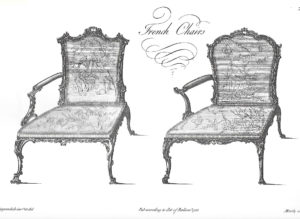
‘French’ chairs, from Chippendale’s 1754 Director…
But as at least as much as the association with the Adam brothers generally, the house is famous for its association with Thomas Chippendale, and indeed is vaunted as one of the first large-scale commissions of arguably the most famous English cabinet maker, executed at about the same time as the issuance of his exquisite pattern book, The Gentleman and Cabinet-Maker’s Director.
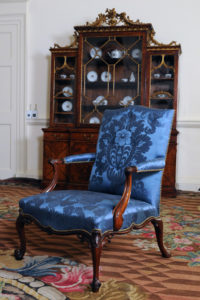
‘French’ chair, as executed by Chippendale. Modern blue damask, matching the period original
No question about it, the furniture does not disappoint. The Chippendale pieces were wrought by the master’s London workshop largely to patterns associated with the Director… and selected by Lord Dumfries himself. The influence of Chippendale within Dumfries House is hard to overstate, as even the large numbers of pieces completed by Scottish cabinet makers were in very many cases executed to match Chippendale’s published designs. I must say that, as a tremendous enhancement to the visual experience, reading Sebastian Pryke’s masterful essay in the Dumfries House guidebook does a wonderful job of contextualizing the furnishing of the house.
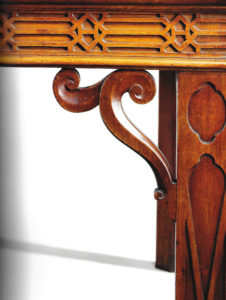
Detail of Dumfries House serving table, attributed to Alexander Peter
Unfortunately, the house and its contents are less than the sum of the component parts. The Adam portion of the house itself is not the prodigious effort wrought by Robert Adam in his later years, and the interior decoration, and certainly the furniture pieces, while lovely in themselves, seem in many cases out of scale and just plopped inside. As Dr Pryke makes clear in his essay, the pieces were selected by Lord Dumfries and included readymade stock, as well as pieces purchased at auction and taken from other of Lord Dumfries’ homes. The effect, sadly, is of something of a jumble that contrasts negatively with the care and effort Robert Adam was able to achieve with his controlled outside-inside decoration, where scale and style and colour were in complete harmony. Those few of my regular blogophiles will note that Lord Dumfries was very much concerned about some modest association of the exterior of the house with the Palladianism of Lord Burlington, noting in contemporary correspondence that some versions of the plan were favorably reviewed by the renowned gentleman architect, the acknowledged style setter of his day.
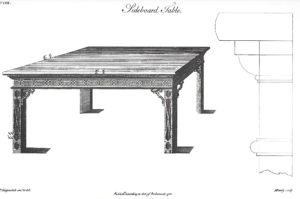
Sideboard table, Chippendale’s Director…
Unfortunately, though, the work of Burlington’s protégé William Kent and the notion of an interior befitting the grandeur of the exterior were ignored. Indeed, as must be implied from the manner in which the house was furnished and the paucity of exterior decoration, Lord Dumfries very much had economy on his mind.
One particularly unpleasant feature that did nothing to enhance the aesthetics of the house was the treatment we received as visitors. Required to book a tour, we did so several weeks in advance and upon arrival, were shunted into a small room with 20 or so other tour visitors to watch a long-ish video of the Duke of Rothesay discussing his role in saving the house and grounds, and his plans, with Dumfries House as the centrepiece, for the regeneration of the local area. It was embarrassingly self-congratulatory and did nothing to aid in the understanding of the house. We were then shunted outside, and introduced to our guide who looked and acted like a Hattie Jacques character from a ‘Carry on…’ film who then quick-marched us around the main and upper floor of the house, and who likewise mouthed with numbing regularity the debt owed to the Duke of Rothesay in saving the house and jumpstarting the local economy. ‘Hattie’ told all of us at the start we could ask questions but her diatribe and the fast pace at which she moved us along made anything other than a quick look impossible. However, along with Keith and our friends Michael and Jane Furse, we took our time and gave everything a careful look. Michael and I were, as it happened, in such rapt, albeit quiet, discussion about a clock case in the entry hall that we didn’t hear ‘Hattie’ chastising us about avoiding private conversation. Jane and Keith heard it, though and let Michael and I know once we were in the car park. Good thing, as I might have treated ‘Hattie’ to some Scots words and phrases, whilst certainly known to the Duke of Rothesay, are not often heard during most tours.
